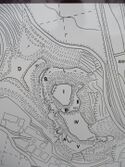Nishi Hirose Castle
Nishi-Hirosejō is a hirayamajiro (hill-and-plains castle) ruin in Nishi-Hirose Township, Toyota Muncipality. Ruins remain in the form of earthworks. Originally the castle, with the Iino River, a tributary of the Yahagi River, to its east, had moats dug from the river to encompass it in the north and
History
Nishi-Hirosejō was built in 1530 by Sakuma Nobunao, a vassal of the Oda Clan, to oppose Higashi-Hirosejō, the castle of the Miyake Clan on the opposite side of the Yahagi River. The fort was an important staging ground for the Oda Clan for invasions of Mikawa.
In 1531 the Miyake Clan, vassals of Matsudaira Ienari, took control of Nishi-Hirosejō. Then the Sakuma Clan under Sakuma Shigeyuki (also called Sakuma Masataka) re-took the castle in 1533. Sakuma Shigeyuki was a vassal of Oda Nobuhide, and so in this way control of the castle was traded between the Matsudaira and Oda clans; the castle sat in the contested space between Matsudaira and Oda territory.
Indeed, Sakuma Shigeyuki was soon forced out of Nishi-Hirosejō by a retalitory Matsudaira Kiyoyasu following his unsuccessful attack on Okazakijō; but reclaimed it in 1535 after Matsudaira Kiyoyasu was assassinated by one of his retainers, Abe Masatoyo. It is Sakuma Shigeyuki who is credited with arranging, on behalf of the Oda Clan, for the assassination of Matsudaira Hirotada, the father of Tokugawa Ieyasu (then called Takechiyo and six years old) at Okazakijō. Shigeyuki paid a retainer of the Matsudaira called Iwamatsu Hachiya to stab Hirotada to death. In retaliation, the Matsudaira sent a warrior called Amano Katakage to Nishi-Hirosejō to assassinate Shigeyuki, but, though injured, Shigeyuki survived the attack.
In 1543, the Miyake Clan once again captured Nishi-Hirosejō. In 1558, the Miyake Clan switched their allegiance to the Oda Clan, sidelining the Sakuma in the Hirose area. However, Matsudaira Motoyasu (Tokugawa Ieyasu) conquered the Miyake's main base of Higashi-Hirosejō in 1560, dealing the Miyake a crippling defeat and subsequently vassalising them. Nishi-Hirosejō was also conquered in 1561.
In 1576, the Sakuma Clan were once again back at their old castle under the auspices of Oda Nobunaga. In 1580, Lord Sakuma Nobumori and his son, Sakuma Nobuhide, were banished to Mount Koya by Oda Nobunaga. In 1582, Nobuhide was pardoned, however, and served Oda Nobutada. Following Oda Nobunaga's death in 1582, Nobuhide served Oda Nobuo and fought for him in the Komaki-Nagakute campaign of 1584.
Field Notes
Nishi-Hirosejō is a hirayamajiro (hill-and-plains castle) ruin in Nishi-Hirose Township, Toyota Muncipality. Ruins remain in the form of earthworks. Originally the castle, with the Iino River, a tributary of the Yahagi River, to its east, had moats dug from the river to encompass it in the north and south. To the west it was connected by a depressed ridge to other hills. The path to the castle ruins goes up via this saddle of the hill.
The castle layout is of a main bailey at the top of the hill. To the west where the castle was weak the earth was banked up, forming an upper and lower layer of dorui (earthen ramparts) with a series of baileys demarcated by slight terracing surrounding the main bailey like a ring below it. To the southeast, following the contours of the hill, were more baileys. The southerly outer bailey had a koshikuruwa (terraced bailey) beneath it, and there is some more dorui in the western section of this bailey.
| Castle Profile | |
|---|---|
| English Name | Nishi Hirose Castle |
| Japanese Name | 西広瀬城 |
| Founder | Sakuma Nobunao |
| Year Founded | 1530 |
| Castle Type | Hilltop |
| Castle Condition | Ruins only |
| Historical Period | Pre Edo Period |
| Artifacts | Dorui |
| Features | trenches |
| Visitor Information | |
| Access | Bus from Toyota-shi Station |
| Hours | 24/7 free; mountain |
| Time Required | 45 mins |
| Location | Toyota, Aichi Prefecture |
| Coordinates | 35.15508, 137.21751 |
|
|
|
| Admin | |
| Added to Jcastle | 2025 |
| Contributor | ART |
| Admin Year Visited | Viewer Contributed |
| Friends of JCastle | |
| Jōkaku Hōrōki | |
| Umoreta Kojō | |
| Oshiro Tabi Nikki | |
| Oumi Meguri Jōroku | |
| Yogo | |











